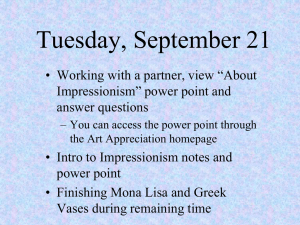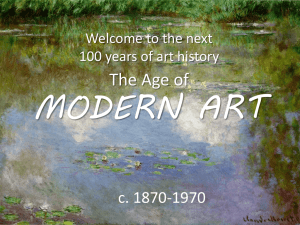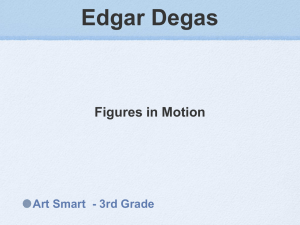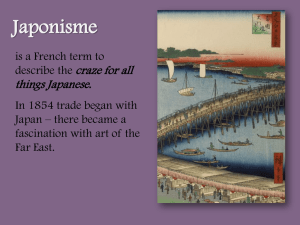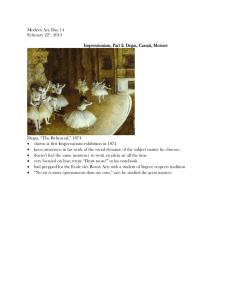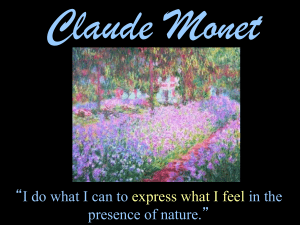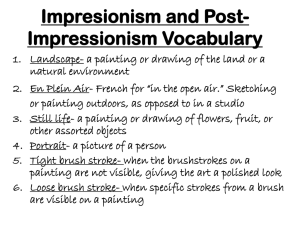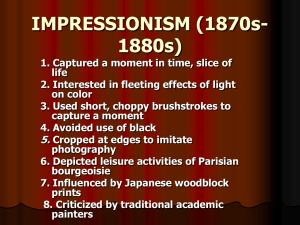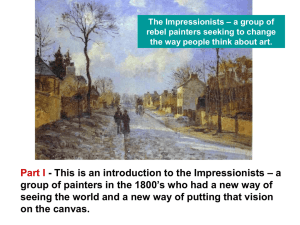Impressionist Works at NOMA
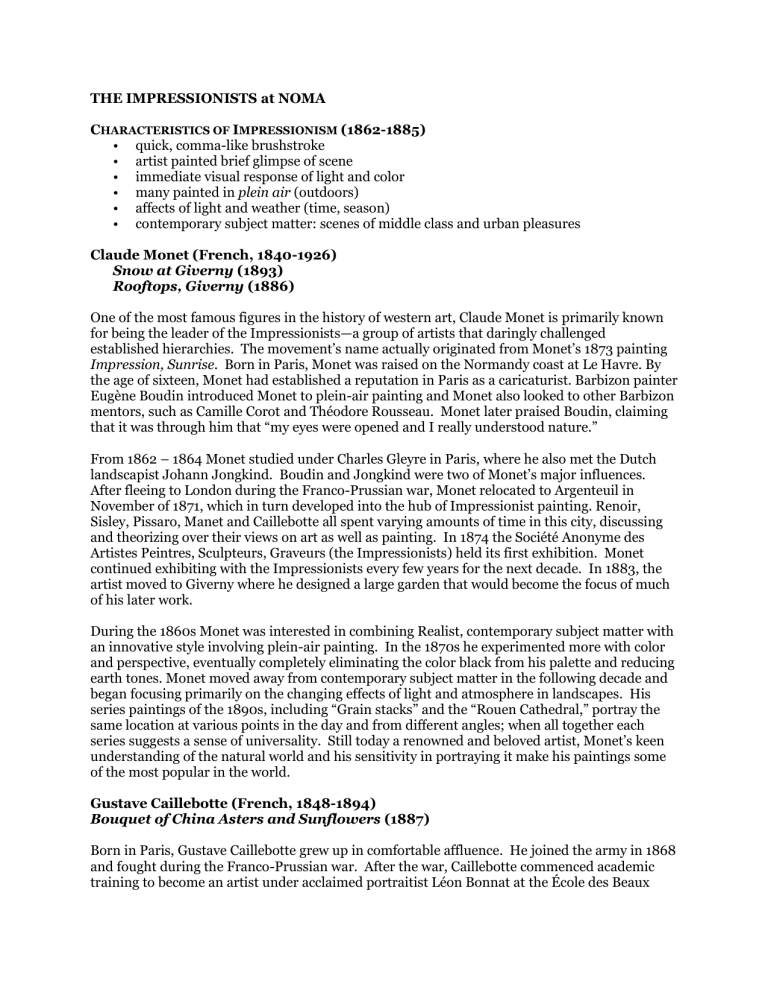
THE IMPRESSIONISTS at NOMA
C HARACTERISTICS OF I MPRESSIONISM (1862-1885)
• quick, comma-like brushstroke
• artist painted brief glimpse of scene
• immediate visual response of light and color
• many painted in plein air (outdoors)
• affects of light and weather (time, season)
• contemporary subject matter: scenes of middle class and urban pleasures
Claude Monet (French, 1840-1926)
Snow at Giverny (1893)
Rooftops, Giverny (1886)
One of the most famous figures in the history of western art, Claude Monet is primarily known for being the leader of the Impressionists—a group of artists that daringly challenged established hierarchies. The movement’s name actually originated from Monet’s 1873 painting
Impression, Sunrise. Born in Paris, Monet was raised on the Normandy coast at Le Havre. By the age of sixteen, Monet had established a reputation in Paris as a caricaturist. Barbizon painter
Eugène Boudin introduced Monet to plein-air painting and Monet also looked to other Barbizon mentors, such as Camille Corot and Théodore Rousseau. Monet later praised Boudin, claiming that it was through him that “my eyes were opened and I really understood nature.”
From 1862 – 1864 Monet studied under Charles Gleyre in Paris, where he also met the Dutch landscapist Johann Jongkind. Boudin and Jongkind were two of Monet’s major influences.
After fleeing to London during the Franco-Prussian war, Monet relocated to Argenteuil in
November of 1871, which in turn developed into the hub of Impressionist painting. Renoir,
Sisley, Pissaro, Manet and Caillebotte all spent varying amounts of time in this city, discussing and theorizing over their views on art as well as painting. In 1874 the Société Anonyme des
Artistes Peintres, Sculpteurs, Graveurs (the Impressionists) held its first exhibition. Monet continued exhibiting with the Impressionists every few years for the next decade. In 1883, the artist moved to Giverny where he designed a large garden that would become the focus of much of his later work.
During the 1860s Monet was interested in combining Realist, contemporary subject matter with an innovative style involving plein-air painting. In the 1870s he experimented more with color and perspective, eventually completely eliminating the color black from his palette and reducing earth tones. Monet moved away from contemporary subject matter in the following decade and began focusing primarily on the changing effects of light and atmosphere in landscapes. His series paintings of the 1890s, including “Grain stacks” and the “Rouen Cathedral,” portray the same location at various points in the day and from different angles; when all together each series suggests a sense of universality. Still today a renowned and beloved artist, Monet’s keen understanding of the natural world and his sensitivity in portraying it make his paintings some of the most popular in the world.
Gustave Caillebotte (French, 1848-1894)
Bouquet of China Asters and Sunflowers (1887)
Born in Paris, Gustave Caillebotte grew up in comfortable affluence. He joined the army in 1868 and fought during the Franco-Prussian war. After the war, Caillebotte commenced academic training to become an artist under acclaimed portraitist Léon Bonnat at the École des Beaux
Arts. Soon after his acceptance into the École, Caillebotte was introduced to Edgar Degas and his rebellious cohorts whose innovative thinking attracted the young artist away from the conservative École.
After his father’s death in 1874, Caillebotte inherited a large sum of money and began to associate full time with the not-yet-established “Impressionist” artists. Though he did not participate in their first showing, Caillebotte displayed eight works at the second Impressionist exhibition in 1876. Throughout his lifetime he consistently bought his contemporaries paintings and coordinated exhibitions—though the public continued to pay the Impressionists little attention. Caillebotte’s own oeuvre reflects an interest in realism and depth perception. His primary subject matters are public spaces of Paris and intimate family life. After 1879, the painter abandoned large-scale projects and produced numerous smaller paintings, a practice more in line with Impressionist notions about art. Most of his paintings from the 1890s are of his garden in Petit-Gennevilliers.
Pierre Auguste Renoir (French, 1841 – 1919)
Vase of Flowers (c. 1900-1910)
Seamstress at a Window(1910)
Auguste Renoir achieved posthumous critical success for his painted scenes of modern leisure produced en plein air that explore the effects of light. Born in Limoges, France, the artist and his family moved to Paris in 1845. Renoir often visited the Louvre during his youth to copy Old
Master paintings. At the age of thirteen he took an apprenticeship at a porcelain factory and soon became a valued decorator. In 1862 the artist entered the École des Beaux Arts where he encountered other artists who would become the Impressionists and was introduced and attracted to plein-air painting.
After repeated rejections from the prestigious Paris Salons during the early 1870s, Renoir joined
Claude Monet in organizing the first Impressionist exhibition in the spring of 1874. Through the
1870s, Renoir adopted a lighter palette and more expressive brushstrokes, indicative of Monet’s influence. The artist’s early paintings also reveal his affinity for the realist Courbet and the romantic colorist Delacroix. As a result of constant strife and argument within the group, Renoir refused to participate in the last two Impressionist exhibitions. He resumed exhibiting at the
Paris Salons in 1878 where he was met with critical and financial success.
After his Impressionist period, Renoir pursued a new style of art more integrated with the past.
Circa 1885 he began to look to Ingres for inspiration as well as Titian, Velazquez and Rubens.
Towards the end of his life (c. 1907)—despite being confined to a chair by rheumatism—Renoir began to produce sculpture.
Camille Pissarro (French 1830 – 1903)
The Laundress at Epernay (1899)
Garden of the Tuileries in Winter (1900)
Camille Pissarro was the only Impressionist to participate in all eight of the Impressionist exhibitions from 1874 to 1886. Largely self-taught, Pissarro was born in St. Thomas (then part of the Dutch West Indies) to a Jewish Portuguese father with French citizenship and a creole mother. At age 12 his father sent him to boarding school in France. In 1850, the Danish artist
Fritz Melbye was working on St. Thomas and reportedly convinced Pissarro to become a full-
time artist. The two men travelled to Venezuela together from 1852 to 1854 where they eventually opened up a studio. There, Pissarro began experimenting with direct observation of nature and light effects as well as observing peasant life; these two practices developed to define his career throughout his life. In 1855 the young artist relocated to Paris, where he briefly attended the École des Beaux Arts, but he found the methods “stifling” and he sought out
Camille Corot as a teacher.
From 1859 to 1870, Pissarro exhibited his work at the Paris Salons and was met with intermittent success. He was interested in the works of Corot, Daubigny, Courbet and Millet and soon met and began associating with Monet and Cezanne. By 1869, the artist had moved to
Luciennes and adopted a complete Impressionist style. After fleeing to London during the
Franco-Prussian war, Pissarro moved to Pontoise in 1871. Pissarro’s work from the first half of the 1870s—painted in England and Pontoise— is generally considered his most successful.
During this time Pissarro formed a friendship with Cezanne. The two artists explored various motifs together, seeking a new kind of art. These explorations would become critical to the development of modern art.
When the Impressionists ceased exhibiting in the mid 1880s, Pissarro aligned himself with the new avant-garde: the Neo-Impressionists. While practicing pointillism alongside Seurat and
Signac, Pissarro concerned himself with the theory of color, and the application of paint. During the last decade of his life, the artist returned to a more pure Impressionist style and focused primarily on rural and urban scenes.
Mary Cassatt (American, 1844 – 1926)
Mother and Child in the Conservatory (1906)
Expatriate American, Mary Cassatt is best known for her images of mother and child painted in a pastel palette. Born in Allegheny City, Pa, Cassatt and her four siblings grew up in an affluent home. At a young age she travelled through Europe with her family and learned to speak
German and French. In 1860, Cassatt entered the Pennsylvania Academia of Fine Arts, a progressive education institution that accepted female students. Determined to study in Paris,
Cassatt was forced to endure numerous obstacles, such as Civil War complications and finding an appropriate travelling partner, before she was able to settle in the art capital of the world.
Once in Paris, Cassatt trained under the academician Jean-Léon Gérome. She worked as a portraitist and genre painting during the first half of her career.
After returning to the US for over a year, Cassatt returned to Europe and visited museums in
Italy, Spain, Holland and Belgium to copy Old Master paintings. Though she was accepted in the Paris Salon in 1868, 1870 and 1872, repeated rejections in the late 1870s led her to align herself with Degas and other Impressionists. Her choice of modern subject matter, which by
1875 was increasingly images of women in the domestic sphere, made her a particularly appropriate fit for the group. She exhibited with the Impressionists four times and was the only
American woman included.
In 1886 Cassatt’s paintings appeared at the first major Impressionist exhibition in the United
States. Two years later, Mary Cassatt created her first mother and child image of her sister-inlaw and her child. The theme of maternity dominated her artistic output for the rest of her life.
She was influenced by an exhibition of Japanese artwork which she saw in 1890. In 1904 she was given the Legion of Honor from the French government.
Edgar Degas (French, 1834-1917)
Portrait of Estelle Musson (1872)
Walking Horse (c. 1865-1885)
Dancer Putting on Her Stocking (c. 1896-1911)
Born in 1834 in Paris, Edgar Hilaire Germain Degas was the eldest of five children of Auguste
Degas, a wealthy banker, and Celestine Musson Degas, a Creole born in New Orleans. Degas studied under his uncle Henri Musson and attending secondary school in Paris. In 1853 he briefly enrolled in law school but finally decided on a career in art. He visited the Louvre, where he tirelessly copied the Old Masters, saying “The masters must be copied again and again, and only after having given every indication of being a good copyist can you reasonably be given leave to draw a radish from nature.” In 1856 he traveled to Italy as was the tradition for young artists and while there he became interested in depicting history scenes.
Upon his return to Paris in 1859 he abandoned historical pictures altogether and directed his artistic energy to contemporary subjects: racetracks, theater, circuses, café scenes, women at work, nudes and ballerinas. Degas’s change in subject matter was encouraged by fellow artist
Edouard Manet, who subsequently introduced the young Degas to a circle of young artists who would become known as the Impressionists. Painting scenes of contemporary life, Degas worked to make his works appear unplanned and spontaneous. His planned spontaneity was derived from his interests in photographs and Japanese prints--both for their informality and cropping.
In 1872 the artist traveled to New Orleans at the urging of his brother Renés and Achille, who had moved to New Orleans in 1866 and opened up Degas Brothers, a firm of commission merchants who imported wine. René, who married his cousin Estelle Musson in 1869, and
Achille lived with their uncle Michel Musson and his daughters in a rented mansion at 2306
Esplanade Avenue. While in New Orleans he painted several portraits of his family as well as
The Cotton Market at New Orleans.
Degas returned to Paris in 1873, and a year later his father died revealing the unfortunate condition of his family’s business. For the first time in his life, Degas was forced to make a living from painting. By the 1890s he achieved critical success, yet his eyesight, which had been failing for years, began to deteriorate. During the last twenty years of his life, Degas was virtually blind.
He turned to pastels during this time because it allowed him to create line and color at the same time.
The portrait of Estelle Musson Degas was created in December of 1872 during Degas’s visit to
New Orleans. Estelle, who married Degas’s brother, René, is shown pregnant with their fourth child. A pink flower was painted in the center of her gently protruding stomach, possibly a reference to her maternal condition. Degas placed Estelle’s hands on the flowers as if emphasizing his sister-in-law’s need to touch. Afflicted with his own eye trouble, Degas was very sympathetic to his blind sister-in-law who he admired for her courage and grace. The New
Orleans Museum of Art acquired the painting in 1965 through the efforts of countless New
Orleanians including nickels contributed by local schoolchildren

